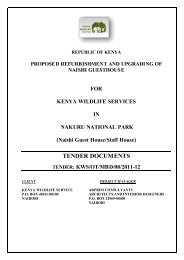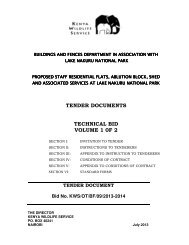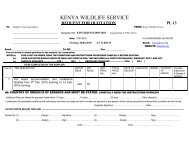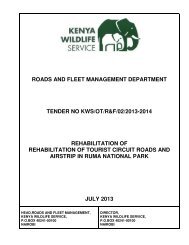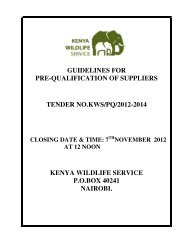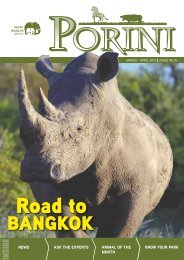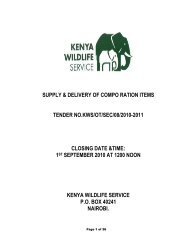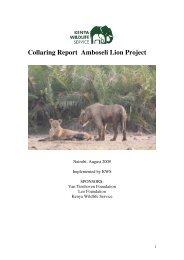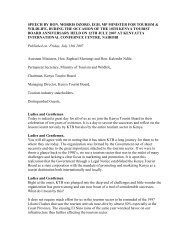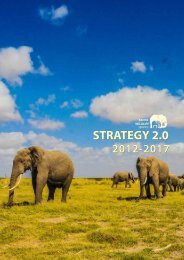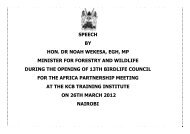Conservation and Management Strategy for the Elephant in Kenya
Conservation and Management Strategy for the Elephant in Kenya
Conservation and Management Strategy for the Elephant in Kenya
Create successful ePaper yourself
Turn your PDF publications into a flip-book with our unique Google optimized e-Paper software.
CONSERVATION AND MANAGEMENT STRATEGY FOR THE ELEPHANT IN KENYA 59<br />
3.3.7 Coord<strong>in</strong>ation <strong>and</strong> Support<br />
[ BELOW ] Plate 39.<br />
KWS veter<strong>in</strong>ary team tak<strong>in</strong>g tissue samples<br />
dur<strong>in</strong>g a collar<strong>in</strong>g exercise - Charles Ooro,<br />
<strong>Kenya</strong> Wildlife Service<br />
Implement an effective<br />
coord<strong>in</strong>ation framework<br />
to support stakeholders<br />
<strong>and</strong> enhance decision<br />
mak<strong>in</strong>g <strong>and</strong> action.<br />
Rationale <strong>and</strong> considerations<br />
The conservation <strong>and</strong> management of wildlife <strong>in</strong> <strong>Kenya</strong> is vested <strong>in</strong> KWS, a parastatal organisation under <strong>the</strong> M<strong>in</strong>istry<br />
of Forestry <strong>and</strong> Wildlife. It is charged with <strong>the</strong> implementation of <strong>the</strong> Wildlife Policy (1975) <strong>and</strong> <strong>the</strong> Wildlife Act<br />
(revised <strong>in</strong> 1989) <strong>and</strong> general plann<strong>in</strong>g <strong>and</strong> management of wildlife <strong>in</strong> <strong>Kenya</strong>. KWS will <strong>the</strong>re<strong>for</strong>e be responsible <strong>for</strong><br />
<strong>the</strong> implementation <strong>and</strong> monitor<strong>in</strong>g of this <strong>Elephant</strong> <strong>Conservation</strong> <strong>and</strong> <strong>Management</strong> <strong>Strategy</strong>. However, a wide<br />
range of stakeholders have <strong>in</strong>terest <strong>in</strong>, <strong>and</strong> resources available <strong>for</strong>, elephant conservation <strong>and</strong> management <strong>in</strong> <strong>Kenya</strong>.<br />
Thus, to achieve <strong>the</strong> overall goals of this strategy, all stakeholders (private sector, NGO partners, donors, relevant<br />
county councils <strong>and</strong> communities) will be required to work toge<strong>the</strong>r under a well-coord<strong>in</strong>ated <strong>and</strong> managed system.<br />
With <strong>the</strong> KWS Strategic Plan 2005–2010, considerable authority has been devolved to Area Managers. This is an<br />
important step <strong>for</strong>ward <strong>in</strong> improv<strong>in</strong>g action at <strong>the</strong> local level, but emphasises <strong>the</strong> need <strong>for</strong> coord<strong>in</strong>ation at <strong>the</strong><br />
national level. In addition, several key elephant population ranges straddle <strong>the</strong> boundaries of different KWS<br />
<strong>Conservation</strong> Areas, so managers of adjacent areas must have coord<strong>in</strong>ated approaches. An extension of this po<strong>in</strong>t<br />
is <strong>the</strong> fact that a number of elephant population ranges also cross <strong>in</strong>ternational boundaries, primarily with Tanzania<br />
<strong>and</strong> to a lesser extent with Ug<strong>and</strong>a, Somalia, Sudan <strong>and</strong> Ethiopia. There<strong>for</strong>e, coord<strong>in</strong>ation of policies <strong>and</strong> strategies<br />
is needed. Where harmonisation is not possible, <strong>the</strong> agreement of boundary ‘buffer zones’ is important <strong>in</strong> <strong>the</strong><br />
management of elephant range, <strong>and</strong> <strong>in</strong> elephant protection <strong>and</strong> anti-poach<strong>in</strong>g activities, <strong>in</strong>clud<strong>in</strong>g discussion <strong>and</strong><br />
jo<strong>in</strong>t <strong>in</strong>ternational action on issues of ivory trade <strong>and</strong> traffick<strong>in</strong>g. It would be useful to consider enlist<strong>in</strong>g <strong>the</strong> support<br />
of conflict-resolution specialists to assist with negotiations, where disagreement may occur over subjects such as <strong>the</strong><br />
ivory trade.<br />
The coord<strong>in</strong>ation framework must <strong>the</strong>re<strong>for</strong>e be carefully considered so that it will be effective, efficient <strong>and</strong> <strong>in</strong>clusive<br />
(Figure 17). The strategy requires buy-<strong>in</strong> from all concerned, but it will be <strong>the</strong> activities that will determ<strong>in</strong>e its success.<br />
Drivers <strong>for</strong> <strong>the</strong> practical aspects of <strong>the</strong> strategy are <strong>the</strong> ones that need to be well established <strong>and</strong> susta<strong>in</strong>ed. The<br />
committees shall only be as large as necessary to achieve <strong>the</strong> purpose, shall only meet as required <strong>and</strong> shall be<br />
focused on action. Much of <strong>the</strong> coord<strong>in</strong>ation shall be done through a strong network, with regular communication.<br />
Sufficient resources need to be applied to <strong>the</strong> coord<strong>in</strong>ation process to ensure it works effectively <strong>and</strong> capacity also<br />
needs to be sufficient to function at a National level.



